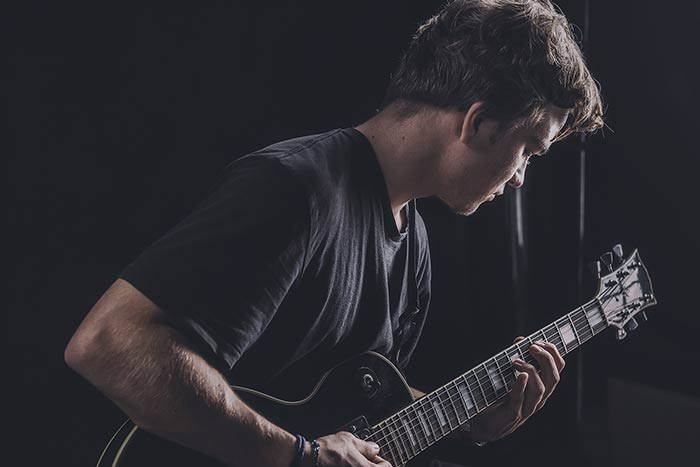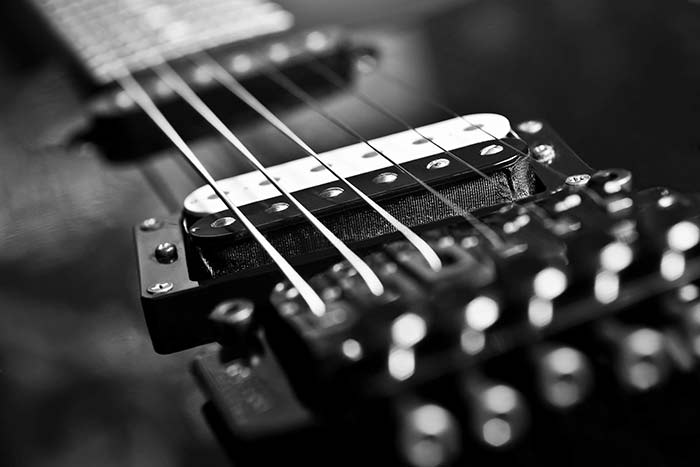Often overlooked, the art of being a great rhythm guitarist is so much more than strumming chords and having to be quieter than the lead guitarist.
It’s actually the rhythm guitarist that has the skill of gluing the band together and giving impact to their sound.
So how do you play rhythm guitar in a band?
Study the greats
A logical place to start when trying to get good at rhythm guitar is to study great rhythm players from great bands that you admire.
Although many of these are names that you will know from some of the biggest bands of all time, there may be some unsung heroes that haven’t received as much recognition to the general public.
Some popular names on the topic of rhythm guitar include Malcolm Young, Keith Richards and Ronnie Wood, James Hetfield, Jimi Hendrix, and James Brown’s guitarists throughout the years (Catfish Collins and Cheese Martin to name a few).
Let’s take a look at what makes each of these guitarists so significant as we dive into playing rhythm guitar in a band.
Lock in with the bass and drums
A name that always comes up when talking about great rhythm guitarists is AC/DC’s Malcolm Young, who’s power and carefully orchestrated parts weaved in and out of his younger brother Angus’ lead and rhythm parts.
Not only was it the arrangement of his parts and songs, but the groove in which he was able to demonstrate this with raw power and conviction.
A key element of Malcom’s playing is his ability to lock in with the bass and drums, being able to place his part so perfectly that the rhythm section sounds like one big wall of sound, rather than three separate musicians playing together at the same time.
Try this approach in your next jam session with your friends. Instead of focusing on the chords or what fret your fingers should be on, look up at the bass player and drummer to really focus in on where they are feeling their groove to lock in as one unit. This is what makes people get up and dance!
Stay out of the way
The same can be said for the guitarists of The Rolling Stones, Keith Richards and Ronnie Wood.
Although both players like to have a turn at lead playing as well, I find that the magic of these two lies in how they are able to intertwine their parts together to create one big sound.
Have a listen to “Start Me Up”, “Beast of Burden” and “Miss You”.
One thing that you’ll hear here is where both players choose to play by themselves, then wait while the other is playing, then come together to emphasise a key rhythmic pattern or riff.
They know when is appropriate to play and when to wait, which is complimentary to the other band members and also the vocals over the top of this.
Another master of this is the late-great Jimi Hendrix, who is known for his rhythm guitar playing just as much or if not more as his lead playing.
Jimi was also master of knowing when to leave space in his rhythm parts, often incorporating lead licks and double stop ad. libs. around chords to create a hybrid of rhythm and lead parts.
As he was also a singer, not only could he feel when felt natural for the guitar to shine in-between vocal breaks, but it would have also no doubt been easier to play a lead riff in-between vocal phrases rather than in the middle of one.
Have a listen to “Red House” to hear this skill in action.
Try this approach in your next rehearsal, leaving room around the vocals instead of noodling over the top.
Make the lead shine
All great rhythm players are able to create a bedrock for the song, giving the vocalist or lead guitarist a solid foundation to play their part confidently on top.
This is most definitely true for lead singer and rhythm guitarist James Hetfield of Metallica, who’s fast down picking on his parts is so metronomic that Kirk Hammett can lock in with ease when playing his solos.
This ability to make the lead shine is what makes all great bands, as if the rhythm section was not tight, the lead instrument or singer would have a hard time executing their part as confidently. Remember that it’s not about you – it’s about the lead!
Leave space
When learning to become a great rhythm guitarist, funk and soul music is a great place to learn simple but effective parts from great musicians.
When talking funk, there’s one name that you must know, and that is of course James Brown. Brown pioneered the funk style with his various lineups of all star musicians, Phelps ‘Catfish’ Collins (older brother of Boosty Collins!) and Hearlon ‘Cheese’ Martin being two of many guitarists.
These guys were masters of leaving space in their parts, making what they did play count. Combine this tasteful playing with their ability to groove in the pocket with the rest of the band and follow James’ cues, and that gives you two master rhythm guitarists.
Have a listen to “Talking Loud And Saying Nothing” and “Soul Power” to hear funk done right by the masters.
Remember, it’s just as much about what you don’t play as what you do play.












